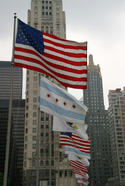Free markets are out of vogue. The unfortunate lesson that policymakers have learned over the past two years is that a big, brainy government that supposedly creates jobs is superior to irrational, faceless markets that just create catastrophic errors. So Washington has seized on the financial and economic crises to enlarge its role in managing the economy—controlling the insurance giant AIG, for example, and trying to maintain high housing prices through tax credits and “mortgage modification” programs. read more »
New York
"A" is for Avenue
Pity poor Matamoras, PA, population 2,600, located on the Delaware River where Pennsylvania, New York and New Jersey all come together. The town has only two named streets: Delaware Drive (parallel to the river), and Pennsylvania Ave. (perpendicular).
Other streets parallel to the river are numbered: 1st, 2nd, 3rd, and so on, up to 10th. The avenues, perpendicular to the river, start with Avenue A in the north, and continue to Avenue S, in the south. Pennsylvania Ave., the main drag, is between “K” and “L”.
What a boring little town! read more »
Who's Dependent on Cars? Try Mass Transit
The Smart Growth movement has long demonstrated a keen understanding of the importance of rhetoric. Terms like livability, transportation choice, and even “smart growth” enable advocates to argue by assertion rather than by evidence. Smart Growth rhetoric thrives in a political culture that rewards the clever catchphrase over drab data analysis, but often fails to identify the risks for cities inherent in their war against “auto-dependency” and promotion of large-scale mass transit to boost the “sustainability” of communities. read more »
The Limits Of Politics
Reversing the general course of history, economics or demography is never easy, despite even the most dogged efforts of the best-connected political operatives working today.
Since the 2006 elections – and even more so after 2008 – blue-state politicians have enjoyed a monopoly of power unprecedented in recent history. Hardcore blue staters control virtually every major Congressional committee, as well as the House Speakership and the White House. Yet they still have proved incapable of reversing the demographic and economic decline in the nation's most "progressive" cities and states. read more »
Why New York City Needs a New Economic Strategy
When Michael Bloomberg stood on the steps of City Hall last week to be sworn in for a third term as New York City's mayor, he spoke in upbeat terms about the challenges ahead. The situation, however, is far more difficult than he portrays it. American financial power has shifted from New York to Washington, while global clout moves toward Singapore, Hong Kong, and Shanghai. Even if the local economy rebounds, the traditional media industries that employ many of Bloomberg's influential constituents likely will continue to decline. read more »
- Login to post comments
What To Look For In Healthcare Reform: Location, Location, Location
A Reuters article that was widely picked up around the globe recently raised the question, Are Doctors What Ails US Healthcare? Comparing the New York suburb of White Plains to Bakersfield, California, the article uses the evergreen two-Americas paradigm to discuss disparities in health care. read more »
Migration: Geographies In Conflict
It's an interesting puzzle. The “cool cities”, the ones that are supposedly doing the best, the ones with the hottest downtowns, the biggest buzz, leading-edge new companies, smart shops, swank restaurants and hip hotels – the ones that are supposed to be magnets for talent – are often among those with the highest levels of net domestic outmigration. New York City, Los Angeles, San Francisco, Boston, Miami and Chicago – all were big losers in the 2000s. Seattle, Denver, and Minneapolis more or less broke even. read more »
It's Crowded Out Here
Do you know that where I'm sitting right now, the population density is 2,787,840 people per square mile?
And here are two other numbers (from Wikipedia) that you shouldn't believe: The population density of Manhattan is 71,201/sq mi. And of Australia: 7.3/sq mi.
And now a number that might just be credible: Hong Kong has 2,346.1/sq mi.
My personal population density I got by allotting myself 10 square feet, and then extrapolating to a square mile. True, as far as it goes, but this must be what Mark Twain meant by "lies, damned lies, and statistics." read more »
Numbers Don't Support Migration Exodus to "Cool Cities"
For the past decade a large coterie of pundits, prognosticators and their media camp followers have insisted that growth in America would be concentrated in places hip and cool, largely the bluish regions of the country.
Since the onset of the recession, which has hit many once-thriving Sun Belt hot spots, this chorus has grown bolder. The Wall Street Journal, for example, recently identified the "Next Youth-Magnet Cities" as drawn from the old "hip and cool" collection of yore: Seattle, Portland, Washington, New York and Austin, Texas. read more »
The White City
Among the media, academia and within planning circles, there’s a generally standing answer to the question of what cities are the best, the most progressive and best role models for small and mid-sized cities. The standard list includes Portland, Seattle, Austin, Minneapolis, and Denver. In particular, Portland is held up as a paradigm, with its urban growth boundary, extensive transit system, excellent cycling culture, and a pro-density policy. These cities are frequently contrasted with those of the Rust Belt and South, which are found wanting, often even by locals, as “cool” urban places.
But look closely at these exemplars and a curious fact emerges. If you take away the dominant Tier One cities like New York, Chicago and Los Angeles you will find that the “progressive” cities aren’t red or blue, but another color entirely: white. read more »






















